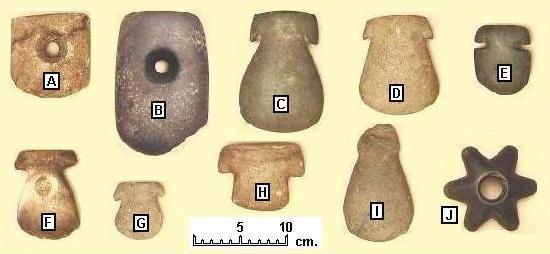All polished stone artifacts shown below were found by people of the Saraguro area in fields around the communities in the upper Saraguro valley or in the mountain cloud forests above the communities (with the exception of B--which was found on the surface at the La Unión (L) site in the low, dry country below Saraguro at the confluence of the Río Leó and the Río Paquishapa.
Sometimes we were shown these already-found objects in peoples' homes. In a couple of cases they were used as children's toys. Note the resemblance of eared axes such as C and D to the heads of horned cattle viewed head-on. Eared axes such these were tied to a string, and children pulled them around, saying "moo, moo." Pulling the axes around in this manner was an obvious imitation of parents who managed their cattle by tethering them to short ropes and used these ropes to control and move them.
In other cases, people brought them to our place to show them to us, knowing of our interest in such things.
These artifacts of polished stone probably reflect the presence of considerable human activity in the region between 1500 and 500 years ago. Most of this time period is usually called the "Integration Period" in Ecuadorian archaeology. The Integration Period is ended by the brief--less than 100 years in most places--Inca occupation. The larger axes were likely important aids in the clearing of the dense forests that probably at that times covered areas above 2000 meters in altitude in the Saraguro region. The star-shaped implements were the heads of war clubs, the circular implement was likely used either a weapon or used on the end of a shaft as a clod-breaker.
Below we have assembled photographs and reconstructed drawings we made of some of the artifacts we were privileged to view in the Saraguro area in the 1960s and early 1970s.
For more interesting topics related to archaeology, visit archaeology excavations.
Archaeology excavation is best known and most commonly used within the science of archaeology. In this sense it is the exposure, processing and recording of archaeological remains.
Thursday, February 10, 2011
BJETOS DE PIEDRA PULIDA / POLISHED STONE ARTIFACTS
Subscribe to:
Post Comments (Atom)

No comments:
Post a Comment